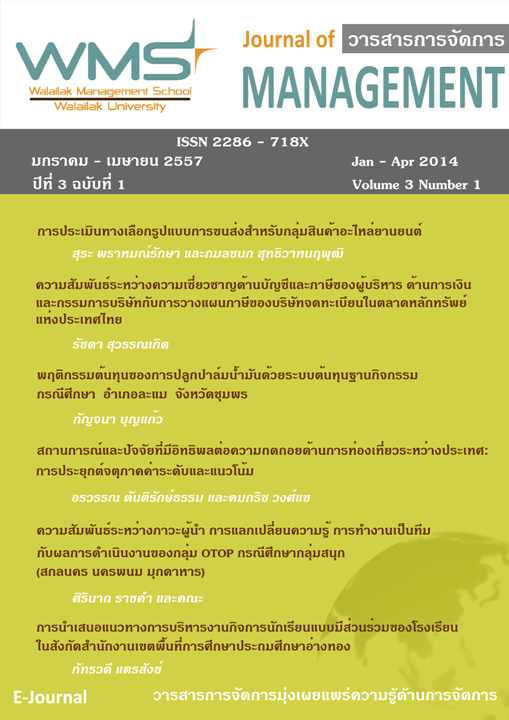Situations and Factors Affecting Recession of International Tourism: An Application of Level and Trend Quadrant
Main Article Content
Abstract
This research aimed to study tourism situation by applying the square part of the level and trend (Level and Trend Quadrant: LTQ) which usually used to study the international competitiveness and using Ordinal Logistic Regression Model (OLR) to verify factors that influence the degree tourism recession. Data adopted in this study is cross-sectional data of tourism arrival growth between 1995 and 2010 of 102 countries. The results found that the falling further behind countries are Bahamas, Moldova and Benin losing momentum countries are France Germany and Greece catching up countries are Egypt Jordan and Albania and not found countries in moving ahead and factors that influence tourism recession are growth of the travel costs and tourism dependency. Higher is growth of tourism expense and tourism dependency and associated with high Level of tourism recession with Significance at o.1 and 0.01 Level respectively.
Article Details
References
ฉลองศรี พิมลสมพงศ์. 2548. การวางแผนและพัฒนาการท่องเที่ยว. (พิมพ์ครั้งที่ 4). กรุงเทพมหานคร: สำนักพิมพ์มหาวิทยาลัยเกษตรศาสตร์.
ชัชชัย สุจริต. 2554. อุตสาหกรรมการท่องเที่ยวเป็นปัจจัยสำคัญต่อการพัฒนาประเทศ. วารสารวิชาการมหาวิทยาลัยราชภัฏอุตรดิตถ์.
ชยาภรณ์ ชื่นรุ่งโรจน์. 2537. การวางแผนการพัฒนาการท่องเที่ยว. คณะมนุษย์ศาสตร์: มหาวิทยาลัยเชียงใหม่.
ทิพย์วรรณ ชาติภูวภัทร. 2549. ปัจจัยที่มีอิทธิพลต่อการท่องเที่ยวของจังหวัดเชียงใหม่. วิทยานิพนธ์เศรษฐศาสตรมหาบัณทิต มหาวิทยาลัยรามคำแหง.
ธงชัย รู้ปิติวิริยะ. 2541. อุปสงค์ของนักท่องเที่ยวชาวไทยที่เดินทางท่องเที่ยวภายในประเทศ. วิทยานิพนธ์เศรษฐศาสตรมหาบัณฑิต. มหาวิทยาลัยรามคำแหง.
มงคล ฤทธิ์พรณรงค์. 2548. ปัจจัยที่มีผลต่อจำนวนนักท่องเที่ยวจากต่างประเทศ. วิทยานิพนธ์ เศรษฐศาสตรมหาบัณฑิต. มหาวิทยาลัยรามคำแหง
อิสรา เหมมินทร์. 2552. ปัจจัยที่มีอิทธิพลต่อการเดินทางท่องเที่ยวภายในประเทศของคนไทย. วิทยานิพนธ์บริหารธุรกิจมหาบัณทิต.มหาวิทยาลัยแสตมฟอร์ด.
Mathieson, A. and Wall,G. 1996. Physical and social impacts, Tourism Economic.16-17.
Arslanturk, Y.,Balcilar,M.andOzdemir, Z.A. 2011. Time-varying linkages between Tourism receiptsand economic growth in a small open economy, Economic Modelling 28,664-671.
Chen,C.F. and Chiou-Wei,S.Z. 2009. Tourism expansion ntourism uncertainty aneconomic growth: New evidence fromTaiwanandKorea, Tourism Management. 30, 812-818.
Fagerberg,J.,Srholec,M.andKnell, M. 2007. The Competitiveness of Nations: WhySome Countries ProsperWhile OthersFall Behind, World Development. 35, 1595-1620.
Fagerberg,J.,Srholec,M.2008. National innovation system,capabilities and economic development, Reserch Policy. 37, 1417-1435.
Kim,H.J.,Chen,M.H.andJang,S.S. 2006. Tourism expansion and economic development:The case of Taiwan, Tourism Management. 27, 925-933.
Parrilla,J.C.,Font,A.R. and Nadal,J.R. 2007. Tourism and long-term growth a Spanish perspective, Annals of Tourism Research.34, 709-726.
Schubert, S.F.,Brida,J.G. and Risso,W.A. 2011. The impacts of international tourism demand oneconomic growth of small economies dependent on tourism, Tourism Management.32, 377-385.
Tang,C.H.H.and Jang, S.S. 2009. Thetourism–economy causality in the United States: A sub-industry level examination, Tourism Management. 30, 553-558
UNWTO. 2011. International Tourism Result And Prospects for Reported 2012
Wang,Y.S. 2009. The impact of crisis events and macroeconomic activity on Taiwan's international inboundtourism demand, Tourism Management. 30, 75-82

